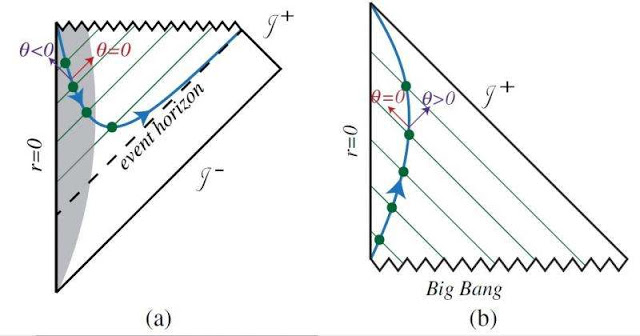Black holes are known to have many strange properties, such as that they allow nothing—not even light—to escape after falling in. A lesser known but equally bizarre property is that black holes appear to “know” what happens in the future in order to form in the first place. However, this strange property arises from the way in which black holes are defined, which has motivated some physicists to explore alternative definitions.
They reported a new area law in general relativity that is based on an interpretation of black holes as curved geometric objects called “holographic screens.”
“The so-called teleology of the black hole event horizon is an artifact of the way in which physicists define an event horizon: the event horizon is defined with respect to infinite future elapsed time, so by definition it ‘knows’ about the entire fate of the universe,” Engelhardt told Phys.org. “In general relativity, the black hole event horizon cannot be observed by any physical observer in finite time, and there isn’t a sense in which the black hole as an entity knows about future infinity. It is simply a convenient way of describing black holes.”
“Holographic screens are in a sense a local boundary to regions of strong gravitational fields,” Engelhardt said. “Future holographic screens correspond to gravitational fields which pull matter together (e.g., black hole, big crunch), whereas past holographic screens correspond to regions which spread matter out (e.g., big bang, white hole).”
The new area law states that the area of a future holographic screen is always increasing in one direction, while the area of a past holographic screen is always increasing in a second (different) direction. This law has some intriguing interpretations when viewed from a thermodynamic perspective and using the idea that spacetime is a hologram. According to the holographic principle, the amount of information or entropy in a given area is related to the surface area. So by interpreting the area as a bound on the entropy, the area law can reveal the direction of thermodynamic time (which, as the scientists note, is not the same as mathematical time).
The new area law states that the area of a future holographic screen (the solid blue line in [a]) is always increasing in one direction, while the area of a past holographic screen (the solid blue line in [b.]) is always increasing in a different direction. Credit: Bousso and Engelhardt. ©2015 American Physical Society
As classical future and past holographic screens obey an area law, researchers expect that quantum holographic screens obey a Generalized Second Law. In particular, researchers expect the quantum extension of their results to yield a rigorous formulation of the Generalized Second Law in cosmology
Physical Review Letters – New Area Law in General Relativity
Researchers report a new area law in general relativity. A future holographic screen is a hypersurface foliated by marginally trapped surfaces. They show that their area increases monotonically along the foliation. Future holographic screens can easily be found in collapsing stars and near a big crunch. Past holographic screens exist in any expanding universe and obey a similar theorem, yielding the first rigorous area law in big bang cosmology. Unlike event horizons, these objects can be identified at finite time and without reference to an asymptotic boundary. The Bousso bound is not used, but it naturally suggests a thermodynamic interpretation of our result.
Arxiv – A New Area Law in General Relativity (5 pages)
SOURCES – Arxiv, Physical Review Letters, Phys org

Brian Wang is a Futurist Thought Leader and a popular Science blogger with 1 million readers per month. His blog Nextbigfuture.com is ranked #1 Science News Blog. It covers many disruptive technology and trends including Space, Robotics, Artificial Intelligence, Medicine, Anti-aging Biotechnology, and Nanotechnology.
Known for identifying cutting edge technologies, he is currently a Co-Founder of a startup and fundraiser for high potential early-stage companies. He is the Head of Research for Allocations for deep technology investments and an Angel Investor at Space Angels.
A frequent speaker at corporations, he has been a TEDx speaker, a Singularity University speaker and guest at numerous interviews for radio and podcasts. He is open to public speaking and advising engagements.


